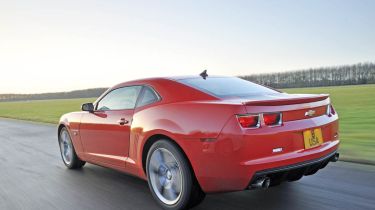Chevrolet Camaro
Retro-styled Chevy aims to knock traditional rival off top of pile
What's in a name? When Chevrolet bosses were asked what a Camaro was at the original car’s unveiling in 1966, they said: “It’s a small, vicious animal that eats Mustangs.”
Fast forward more than 40 years, and the flagship muscle cars from Chevy and Ford are still at each others’ throats. Now in its fifth generation, the Camaro is aiming to finally knock the Mustang off the top
of the sales charts after four decades as runner-up. And judged on looks alone, it has every chance of success.
Few cars attract as much attention as the Camaro. The retro lines give it a muscular and menacing appearance that makes the Mustang look ordinary.
Our bright red, range-topping 2SS test car is endowed with even greater visual impact by the addition of an optional RS styling pack. This adds thick black stripes that stretch from nose to tail, a bootlid spoiler and 20-inch alloy wheels with a polished finish.
The Camaro is nearly as eye-catching on the inside as the outside. The speedo and rev counter are mounted in bold rectangular housings, while a set of four auxiliary dials is stacked in front of the gear selector.
At night, the interior is given a lift by ambient blue lighting strips that run across the top of the dash and along the door-mounted armrests. Only the occasional pieces of hard and shiny plastic trim spoil the look and feel of the cabin. Finding a comfortable driving position is straightforward, though, as there is a wide range of seat and steering wheel adjustment, while the rest of the interior is roomier than the Mustang’s.
The Camaro is also more refined than the Shelby. At idle, the 6.2-litre V8 engine emits only a muted burble, although as it’s normally aspirated, it can muster ‘only’ 400bhp to its supercharged rival’s 540bhp.
Even so, the Chevy proved faithful to its muscle car roots at the test track.
It sprinted from 0-60mph in only 5.4 seconds, while its in-gear acceleration was almost a match for the ferocious Ford’s. Better still, the V8 delivers a true NASCAR-style soundtrack. The Camaro really comes into its own on public roads, however. With an all-independent suspension set-up and six-speed paddleshift automatic transmission, the Chevy feels much more modern from behind the wheel.
Turn into a corner and there’s still a fair amount of body roll, but the car remains stable and composed. And while the steering lacks feedback, it is precise. Mind you, the Camaro’s left-hand-drive layout can be an issue on tight back roads.
The upshot of the car’s soft springing is a supple ride, which combines with the low noise levels to make the Chevy a comfortable long-distance cruiser.
Factor in its lower price and more eye-catching looks, and the Camaro could be set for a famous victory...
Details
Chart position: 1
WHY: Not many cars can match the Camaro’s kerb appeal. Menacing looks and sheer exclusivity mean it’s always the centre of attention, and performance is strong. The Chevy is cheaper than the Ford, but still pricey compared to European rivals.



